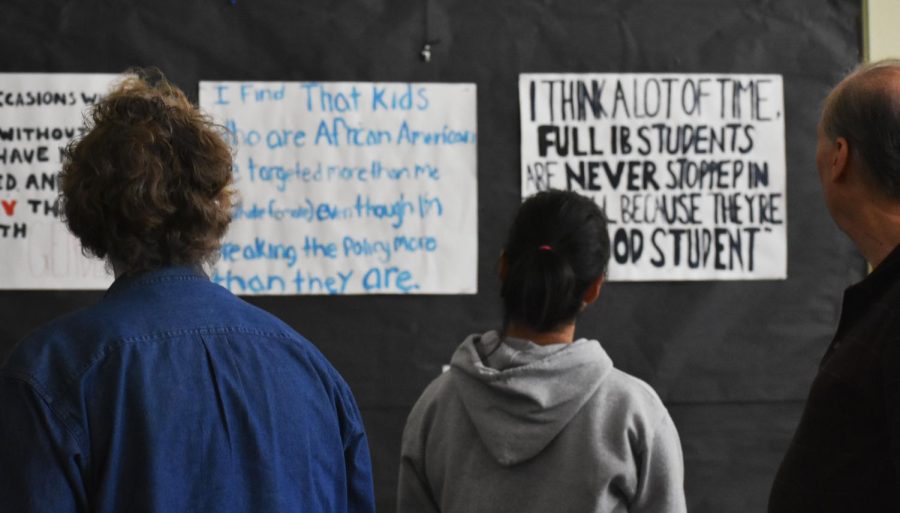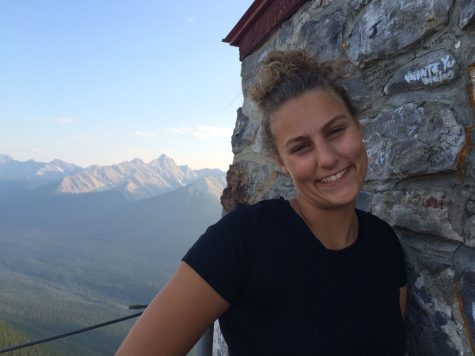Equity Warriors
June 8, 2018
The responsibility for the disparities among our young people rests with adults, not the children. –Racial Educational Equity Policy, Board Policy, PPS
“I won’t be stopped but then admin will stop POC behind me. Being white is a pass in itself. It would be nice if school was less like a prison.”
October: A student of color comes into CARE and says they are being stopped and followed in the hallway. CARE leadership has a conversation about the hallway policy and notices that students in class of color are being stopped disproportionately.
Introduction
Cleveland’s predominantly white population has led to many unresolved racial equity problems in classrooms and hallways, leaving students and staff of color feeling marginalized and unwelcome. Since October, the Cleveland Alliance for Racial Equity (CARE Leadership) has brought awareness to the hallway policies and classroom climates at Cleveland.
CARE Leadership was formed by seniors Adam Nayak and Andy Ho last year in response to the lack of dialogue about race at Cleveland. “I wanted to create a space in which we can start formulating conversations around race in order to change the racial climate at Cleveland,” Nayak said last year. Initially starting out as a club, it soon became an elective leadership class now taught by Lynne Allers. CARE Leadership fosters a welcoming learning space for students of different racial and ethnic backgrounds to discuss topics of race and intersectionality with the goal of improving the overall racial climate for students of color at Cleveland.
Distribution and Analysis
In October, an African American student came into CARE Leadership and expressed their concerns regarding the hallway policies. They reported that they had been followed and repeatedly stopped in the hallways even if they had a pass. Allers asked the class, “Raise your hand if you have ever been stopped or followed in the hallway.” A disproportionate amount of students of color raised their hands in comparison to their white counterparts. Then Allers asked, “Now raise your hand if you sometimes or never carry a hall pass.” The majority of the white students raised their hands, noticing, again, the stark difference in the show of hands.
The distinct show of hands indicted that students of color were more likely to be stopped in the hallway by a staff member whether or not they had a hall pass. There was a contrasting difference in the treatment students of color and white students received in Cleveland’s hallways. This sparked an in-class discussion amongst the students of color and white students. Senior Andy Ho said, “There are many, many racial equity issues here at Cleveland as we all know, so the hallway is just one place to start. We noticed that there’s this racial profiling of students at Cleveland because there are people of color being stopped regardless of if they have a hall pass.”
The current hallway policy asks that students stay in class for the entirety of the class period unless given permission by a teacher. Only one student is allowed to leave the classroom, and they must carry a hall pass with them, returning within five to 10 minutes.
CARE Leadership created a survey in order to further investigate whether or not the results of the discussion reflected the hallway experience of the Cleveland student body. Following the survey’s creation, CARE students distributed it during sixth period. They received approximately 1,200 student responses, three fourths of the reported student body.
The findings from the surveys largely reflected the discussion that CARE had before the distribution of surveys; generally students who self-identified as a person of color were more likely to be stopped and/followed in the hallway. Hernandez-Felipe said, “We found that there was a disproportionate amount of students of color that were being stopped in the hallways which is very problematic seeing as how these target minority groups are feeling as if they are being attacked in an already very white dominated space.”
Students of color were typically also more conscious of the hallway policy itself in comparison to white students. “We realized that the people of color were more aware of disciplinary actions and they knew the policies at our school better at our school than the students that were white. And that typically white students would not be stopped in the hall, where students of color would be stopped or followed,” said Ho. This ironic finding exemplifies how white students have the privilege of being less aware of these hallway policies in contrast to students of color.
Findings from the survey also indicate that appearance factored into whether or not a student was followed or stopped. “It’s also not just about race, it’s also about how you look,” said sophomore Thida Lam. “We’ve had a few comments like ‘I’ve been followed by administration because I’m trans,’ and [one person] said, ‘Asian students with a darker skin tone are stopped more than Asians with a fairer complexion.’ The darker their skin, the more often they’ll be stopped.”
Having a certain skin color complexion does not always indicate a racial identity. The way someone is perceived is separate from an actual identity. “One of the conversations we had around that was how to present race when we’re presenting [to the administration],” said CARE class member Caroline Diamond. “We wanted to show that when a security guard or the administration stops students it is based on their initial perception of the skin color of that student which maybe does not coincide directly with what that student identifies as.”
An implicit bias informs us how to initially perceive someone. Everyone has an implicit bias—a cognizant understanding of stereotypes, ideas, and attitudes that we have against or for someone or something. Each survey response became an essential piece to uncovering the disconcerting truth that white staff at Cleveland have an implicit bias against students with a darker complexion, no matter their race.
Staff Presentations
On Tuesday Feb. 13, CARE Leadership presented their findings to Cleveland administration and staff from the Climate and Equity Teams, which focus on providing a safe and equitable school environment for all students. Audience members were asked to refrain from taking notes or using their cell phones in order to give their full attention as students explained their process and results. In addition, posters bearing comments from the survey were hung up around Allers’ room to amplify student voices.
CARE students took turns presenting the findings from the data and also explained the process and development of their analysis. Teachers remained silent for the duration of the presentation, considering the information CARE was showing them.
Those in attendance at the presentation seemed open to moving forward with the information. The presentation of data proved to be a moment of truth for staff members, opening their eyes to the many realities people of color face in the halls and classrooms of Cleveland. “I think the way they presented it in terms of having both hard data as well as stories from students I think was so much more effective than I even imagined in terms of understanding the complexities of what they looked at but also the clarity of what’s happening,” Heidi Tolentino, Cleveland counselor, said after the meeting on Feb. 13.
“I [personally] haven’t had students tell me that they were stopped in the hall because of their appearance but it doesn’t surprise me that students do get stopped in the hall because of their appearance,” said science teacher Seamus Shalman, who also attended the presentation on Feb. 13. “There’s implicit bias and people make a lot of assumptions about other people based on race, gender, class. So it didn’t surprise that the data came out to back that up.”
The all-staff presentation that took place on March 20 included CARE’s survey data followed by breakout sessions intended to promote conversation surrounding that data. “I think staff was genuinely interested and wanting to know more about what CARE has been doing this year, because we are so new,” said Allers. “The breakout sessions were a different story. We had quite a few teachers not go to the breakout sessions.”
Teachers were interested in why students were leaving class, and wanted to know if students being in the hallway frequently was indicative of something deeper going on in classrooms at Cleveland.
Community Presentation
On April 18, CARE moved forward with their presentation, this time inviting community members as well as families of students in the class to come see it. In addition, Oregon state legislators Tawna Sanchez and Lew Frederick were present. Sanchez is a Democratic legislator serving in the Oregon House of Representatives. She represents the 43rd district, which covers north and central Portland. Frederick preceded Sanchez in representing the 43rd district in the Oregon House of Representatives, and he now represents the 22nd district in the Oregon State Senate. The 22nd district encompasses parts of north and northeast Portland. Additionally, Jo Ann Hardesty, leader in the NAACP and City Council Candidate and the PPS Equity TOSA were present. Parents of CARE students were also invited. They stand in solidarity with students and the work CARE Leadership has done.
Before the presentation began, the audience was invited to observe the many posters that displayed comments that CARE Leadership received from students in the “additional comments” section of the survey they distributed. The student survey comments were contrasted with quotes from the PPS equity policy that were also printed on posters around the room in order to juxtapose equity policies with the reality students of color in majority white schools face. Students repeatedly referenced grounded theory, critical race theory, and the right to research as guiding principles and techniques in their analysis of the data.
Student Presentation
On Apr. 24, CARE presented the hallway survey data to the entire student body in the form of assemblies in first and second period. The presentation as a whole made an impact on students, who generally found it thought-provoking. The aforementioned curiosity from teachers about why students were in the hallways frequently prompted CARE to pose that question to the student body in the form of slips passed out during the assembly that were then collected.
“I really enjoyed the presentation. They used statistics and facts that made it a lot more real.” said sophomore Laurel Cameron. “I really liked how they got across the issue of how…people of color are getting stopped with or without a pass, and the statistics were amazing,” added junior Lida Alexander.
Furthermore, students acknowledged CARE for their efforts in not pointing the finger at specific people, but rather drawing attention to flaws in the current hallway policy. “I thought it was really informative and they did a good job of addressing the issue without calling anyone out,” junior Isabel Reinhart said.
After the presentation, CARE students reflected on their goals. “My hopes are that [students] have a larger awareness of where they stand in this whole dynamic in Cleveland High School,” said junior Saiming Wenger. “I want this school to be informed,” said Lydia Wade-Sully. “There’s a lot of people at this school [who are] not racist, they’re not trying to be, but they’re just ignorant. They just don’t know.”
Teachers were also impressed by the school-wide presentation. “I am happy that we are seeing student leaders step to bring to the forefront an issue that I feel like is unseen by a lot of teachers and students of the school because of their privilege,” said health teacher Gaye Chapman.
“The information is important for everyone to know. I think it’s good that we take a look at what’s happening in our school and start to question,” said English and Freshman Leadership teacher Susie Brighouse. “I look forward to seeing something come about, seeing change and some positive change with all of the student body and not putting it all on the CARE team to make all of those changes happen,” she added.
Alex Karpstein and DeAngelo Edwards were also present during the student body data presentation. They are Cleveland’s fifth and sixth security guards since this school year. Karpstein expressed support for the data CARE Leadership presented, but also wanted the student body to understand his role as a campus security guard. “With this communication that we’re having with the student body, I think this is a good step to get everyone on the same page and understand where we’re coming from,” Karpstein said.
Equity Funding
CARE has addressed the recently announced reallocation of equity funding by Portland Public Schools in their presentations. According to PPS’s proposed budget for the 2018-2019 school year, equity funds will be reallocated based on a new formula that is intended to show where the funds are needed most, theoretically allowing the funds to be used most effectively. Schools will now have to meet different need thresholds than in previous years to receive funding, and continued funding over multiple years will be tied to data proving that students are benefiting from the equity funding.
According to the reallocation plan, for a school to receive additional equity funding for the 2018-2019 school year, more than 15 percent of students at that school must be on free-and-reduced lunch and 40 percent of their student body must be considered historically underserved. Historically underserved, according to PPS, means students with disabilities, extra language needs, lower incomes, and students from ethnic and racial minority groups. These criterion have been used to justify and allocate equity funding at the elementary and middle school levels since the implementation of the equity policy in 2010, but this is the first time they are being applied to high schools. Cleveland does not meet either of those criterion, meaning our school will experience a reduction in equity funding starting next school year. The data that CARE has collected demonstrates that equity issues persist at Cleveland, making the cut in equity funding an even harsher reality.
Next Steps
CARE has worked tirelessly for eight months to bring this issue to light. Through the presentation of the data they have collected, they have prompted administrators, staff, students, and the community to reexamine how they interact with this school on a daily basis. They have opened the door for meaningful conversations about how our school can become more welcoming, inclusive, and respectful of students’ identities.
Dean of Students Scott Burns has listened to CARE’s presentation more times than anyone else at Cleveland, and expressed a desire to learn and listen on behalf of administration. “The start of it is to continue to have the conversation surrounding the issue, to have logical, respectful conversations that allow everyone to be heard…You have to bring it up. You have to have conversations about it,” said Burns.
“This is a school for students, not adults,” said Allers. “We work for you all, we should be working for you all, giving you a good experience, providing you a good learning environment, providing you a safe and welcoming environment.”
Furthermore, in the face of cuts to Cleveland’s equity funding next year, the data collected by CARE serves as a potent reminder that Cleveland is still grappling with a host of equity issues. It is the duty of staff and administration to provide a safe and welcoming environment for all students, regardless of their identity. That is a task that will be even harder to accomplish with a reduction in equity funding.
CARE intends to proceed in their exploration of this issue, collecting and analyzing the data they collected from students at the assemblies about why students are leaving class. They want to contrast the student responses with staff perceptions of students who are leaving class and why they are leaving class.
As a first step in combating the issues that have been identified, CARE planned the Diversity, Equity and Inclusion Summit. It took place at flex on April 26. It featured a multitude of clubs present at Cleveland leading workshops about how they incorporate diversity, equity, and inclusion into their activities and their missions. It is hoped that this summit will be the first of many events aimed at educating the Cleveland community. Continued discussions and education surrounding the equity issues that persist at our school are the first steps in creating a safe, welcoming, and inclusive environment. Only when we achieve that environment can we truly progress as an educational community.













